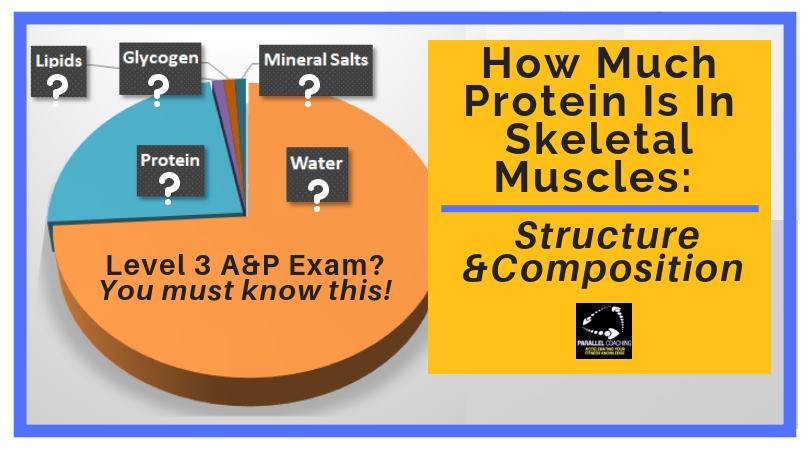If you are studying for your Level 3 Anatomy and Physiology exam … then stop scrolling, you need to know How Much Protein Is In Skeletal Muscle!
We have the answer for you here in this blog, alongside the structure of the skeletal muscle and key muscle facts… as well as a mock question to help you test your knowledge and check your understanding.
Key Skeletal Muscle Facts:
A whole skeletal muscle is considered an organ of the muscular system. Each organ or muscle consists of skeletal muscle tissue, connective tissue, nerve tissue, and blood or vascular tissue.
Muscles make up 30 to 40 percent of the human body weight.
How Much Protein Is In Skeletal Muscle?
Their composition is:
70-75 percent water,
18-23 percent protein,
1 percent glycogen,
1 percent lipids,
1 percent mineral salts…
There are two sorts of muscles: striated (skeletal muscle, myocardium, etc) and smooth muscle.

Skeletal muscles vary considerably in size, shape, and arrangement of fibers.
They range from extremely tiny strands like the muscles found in the inner ear called the stapedium to large muscles such as the quadriceps in the upper leg.
Some skeletal muscles are broad in shape such as the Latissimus Dorsi and some narrow such as the tibialis anterior.
Arrangement Of Muscle Fibers.
In some muscles, the fibers are parallel to the long axis of the muscle such as the Rectus Abdominus. Other muscles converge to a narrow attachment such as the pectoralis major and finally, some muscles run diagonally to the midline of the body and classed as an oblique Arrangement such as the internal and external obliques.
Structure Of a Skeletal Muscle

Each skeletal muscle fiber is a single cylindrical muscle cell. An individual skeletal muscle is made up of hundreds, if not thousands, of muscle fibers bundled together and wrapped in a connective tissue covering.
Each muscle is surrounded by a connective tissue sheath called the epimysium.
Fascia, connective tissue outside the epimysium, surrounds and separates the muscles.
Portions of the epimysium project inward to divide the muscle into compartments.
Each compartment contains a bundle of muscle fibers. Each bundle of muscle fiber is called a fascicle and is surrounded by a layer of connective tissue called the perimysium.
Within the fascicle, each individual muscle cell, called a muscle fiber, is surrounded by connective tissue called the endomysium.
Skeletal muscle cells (fibers), like other body cells, are soft and fragile. The connective tissue covering offer support and protection for the delicate cells and allow them to withstand the forces of contraction. The coverings also provide pathways for the passage of blood vessels and nerves.
Commonly, the epimysium, perimysium, and endomysium extend beyond the fleshy part of the muscle, the belly, to form a thick rope like tendon or a broad, flat sheet-like aponeurosis.
The tendon and aponeurosis form indirect attachments from muscles to the periosteum of bones or to the connective tissue of other muscles.
All muscles MUST cross a joint and is attached to bones by tendons at both ends.
One of the bones remains relatively fixed or stable [the origin] while the other end moves as a result of muscle contraction [the insertion]. Check out this blog to learn more:
How To Learn The Origins and Insertions of Muscles << click to read more
Skeletal muscles have an abundant supply of blood vessels and nerves. This is directly related to the primary function of skeletal muscle, which is a contraction. Before a skeletal muscle fiber can contract, it has to receive an impulse from a nerve cell.
Generally, an artery and at least one vein accompany each nerve that penetrates the epimysium of a skeletal muscle. Branches of the nerve and blood vessels follow the connective tissue components of the muscle.
Key Summary:
How Much Protein Is In Skeletal Muscle? Approximately 18-23% of the skeletal muscle is protein, and 70-75% is water
Skeletal Muscles vary in size, shape and arrangement of muscle fibers
The structure of a muscle is highly organised.
You need to know these key points for your Level 3 Anatomy and Physiology Exam Physiology
Here’s what learners are saying about our Revision Mastery Bootcamp:
Here are a few more muscle questions to tackle – make sure to drop your answers below in the comments box:
Skeletal Muscles Mock Questions
1. How Much Protein Is In Skeletal Muscle?
A. 12%
B. 57%
C. 23%
D. 75%
2. What is the name given to the connective tissue that surrounds the Fascicles?
A. Perimysium
B. Epimysium
C. Periosteum
D. Endomysium
3. Which of the following is a narrow muscle that attaches the scapula to the radius?
A. Pectoralis Major
B. Latissimus Dorsi
C. Biceps Brachii
D. Biceps Femoris
Download More Mock Questions for FREE just link these by clicking this link: MOCK QUESTIONS
Answers
1 = C
2 = A
3 = C
Dedicated to More
Parallel Coaching
P.S. You can also find us on the following platforms:
Instagram: https://www.instagram.com/parallelcoaching
Facebook: https://www.facebook.com/ParallelCoaching
Twitter: https://twitter.com/ParallelCoach
YouTube: http://bit.ly/2F1Z1bs


